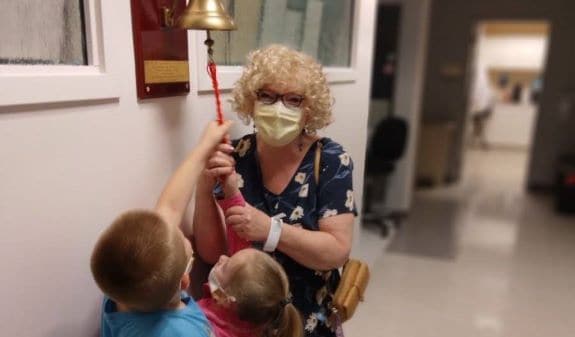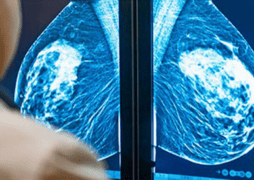The goal of treating early stage and locally advanced breast cancer is to remove the cancer and keep it from coming back (called recurrence or relapse). With modern treatment, rates of survival without recurrence continue to improve. Unfortunately, there is always a chance that breast cancer may return. However most people diagnosed with breast cancer will never have a recurrence. Follow-up medical care helps ensure any recurrence is properly treated.
Understanding more about breast cancer recurrence and what your follow-up care should (and should not) include may help you feel more in control of your health. It may also help you to discuss these topics with your health care provider.
What are recurrence and metastasis?
Breast cancer can recur at the original site (called recurrence or local recurrence), as well as spread to other parts of the body (called metastasis or distant recurrence).
- Recurrence (local recurrence) means the original breast cancer has returned to the breast, chest or nearby lymph nodes.
- Metastasis (distant recurrence) means the original breast cancer has returned and spread to other parts of the body (most often to the bones, lungs, liver or brain).
What are my chances of breast cancer recurrence?
The chance of breast cancer recurrence varies from person to person. It depends on the original diagnosis, the types of treatment given and many other factors. Most recurrences occur within the first 10 years after treatment.1-2
Talk to your health care provider about your chances of recurrence during follow-up visits. He/she will discuss any signs of recurrence and ask you about any symptoms or concerns you may have.
Risk of a new breast cancer
Breast cancer survivors have an increased risk of getting a new breast cancer (called a second primary breast cancer) compared to people who have never had breast cancer.3-4 Unlike a breast cancer recurrence (a return of the first breast cancer), a second primary tumor is a new cancer unrelated to the first.
Follow-up medical care for breast cancer survivors
All breast cancer survivors should see their health care providers on a regular basis. This care consists of the primary care and health screenings that everyone should get. In addition, the goals of follow-up care for survivors include:
- Finding any breast cancer recurrence or metastasis
- Finding any new breast cancer
- Discussing behaviors that may lower the risk of recurrence and metastasis
- Managing any side effects related to breast cancer treatment (such as menopausal symptoms)
- Providing medical updates that might change your follow-up care
- Providing emotional support
- Providing time to ask questions and share concerns
Tests included as part of routine follow-up care
Health care providers use these tests to check for signs of recurrence:5
- Physical exams
- Mammograms
Follow-up care for survivors also includes:5
- Bone health tests
- Pelvic exams (for women)
Find a schedule of recommended care for breast cancer survivors.
How is a recurrence or metastasis found?
Recurrence
A breast cancer recurrence is usually found during a mammogram or a physical exam. If a recurrence is found, tests will be done to see if there is also metastasis.
A recurrence is treated in much the same way as the first tumor. As with a first breast cancer, treatment varies from person to person. Learn more about treatment for breast cancer recurrence.
Metastasis
Metastasis is usually found when symptoms are reported during follow-up office visits. Symptoms may include:
- Shortness of breath
- Weight loss
- Bone pain
Don’t panic if you have symptoms like weight change or bone pain. These are common and usually do not mean the breast cancer has spread. However, any of these symptoms should be discussed with your health care provider.
Based on the symptoms above, tests will be done to check for metastases. The three main tests are:
- A blood test to check for breast cancer that may have spread to the liver lungs or bones
- Bone scans to test for spread to the bone
- X-rays or CT scans to test for spread to the chest, abdomen and liver
Positron emission tomography (PET scans) and other tests for metastases may be done, depending on a person’s symptoms and the findings from the three main tests.6 Learn more about tests for metastases.
Breast cancer most often metastasizes to the bones, lungs, liver or brain. Although it has spread to another part of the body, it is still considered and treated as breast cancer. For example, breast cancer that has spread to the bones is still breast cancer (not bone cancer) and is treated with breast cancer drugs, rather than treatments for a cancer that began in the bones. Learn more about treatment of metastatic breast cancer.
Tests not included as part of routine follow-up care
For people with no symptoms of metastases, blood and imaging tests (other than mammography) are not a standard part of follow-up care. Using these tests to check for recurrence or early metastases in people without symptoms does not increase survival.7 After reviewing the scientific evidence, the American Society of Clinical Oncology (ASCO) determined these tests should not be part of routine follow-up care for breast cancer survivors.7
In 2012, ASCO identified five ways health care providers could choose procedures more wisely to avoid using tests and treatments that have not been shown to benefit cancer patients (see all five ASCO Choosing Wisely recommendations). Two of the five recommendations were related to follow-up care for breast cancer survivors.7
1. Don’t use PET scans, CT scans and bone scans to stage ductal carcinoma in situ (DCIS) or early breast cancer (stage I or stage II) at low risk for metastasis.
2. Don’t use routine blood and imaging tests (other than mammography) for breast cancer survivors with no symptoms of metastasis. These tests include:
- Blood tests for biomarkers, such as CEA, CA 15-3 and CA 27-29 (learn more about these tests)
- PET scans, CT scans and bone scans
ASCO concluded these tests do not improve survival for people without symptoms of metastasis. And, for some people, these tests may cause harm by leading to more invasive tests, unneeded treatment and/or exposure to radiation. The benefits of these tests are limited to breast cancer survivors with metastasis or symptoms of metastasis (learn more).
Support
Fear of recurrence
Follow-up visits with your provider are a good time to talk about how you’re coping emotionally. Many survivors are afraid they still have breast cancer or that it will come back. These fears are normal. For some people, talking to a counselor or joining a support group can be helpful. Your provider may be able to help you find a counselor or support group.
Recurrence
If the breast cancer returns, you may have a strong emotional and physical effect. A support group, especially one focused on breast cancer recurrence, may help you address these concerns. Your provider may be able to help you find a support group.
Learn more about support groups and other types of social support.
| Komen Support Resources |
| Our breast care helpline 1-877 GO KOMEN (1-877-465-6636) provides free, professional support services and help finding local support groups. Our trained and caring staff are available to you and your family Monday – Thursday 9 a.m. EST – 7 p.m. EST and Friday 9:00 a.m. – 6:00 p.m. EST. Our Message Boards offer online forums for breast cancer survivors to share their experiences and advice with other breast cancer survivors. Our Co-Survivor section has detailed information and resources for family and friends. Our Family, Friends and Caregivers forum within the Message Boards offers co-survivors a place to share their own unique experiences and challenges. Our fact sheets, booklets and other education materials offer additional information for survivors and co-survivors. |
Dr. Julie Gralow, M.D., a Komen Scholar and Director of Breast Medical Oncology at Seattle Cancer Care Alliance and Professor of Medical Oncology at the University of Washington School of Medicine sums it nicely. “Once breast cancer treatment ends, it’s important to establish a survivorship care plan with your health care team. Breast cancer diagnosis and treatment frequently result in long-lasting effects, impacting both physical and emotional health. Regular follow-up visits can help address long-term effects of treatment, and also detect recurrence. Communication is key – even in between visits if issues arise. Healthy lifestyle behaviors, such as physical activity and maintaining a healthy body weight have been shown to improve overall health and may also help reduce the risk of recurrence. Take charge of the factors over which you have control!”
What is Komen doing?
Since 2006, Komen has invested nearly $100 million into nearly 200 research grants that focus on metastasis and recurrence. Examples of some projects include:
- Identifying the causes of recurrence and metastasis
- Developing and testing new therapies to prevent and/or treat recurrence or metastasis
- Discovering new methods for predicting or detecting recurrence and metastasis.
In addition, a few grants focus on the fear of recurrence and the effect that these fears have on treatment outcomes as well as quality of life issues related to recurrence and metastasis.
For more information on Komen’s research into metastasis, please see the Research Fast Facts: Metastasis.
References
- Clarke M, Collins R, Darby S, et al. for the Early Breast Cancer Trialists’ Collaborative Group (EBCTCG). Effects of radiotherapy and of differences in the extent of surgery for early breast cancer on local recurrence and 15-year survival: an overview of the randomised trials. Lancet. 366(9503):2087-106, 2005.
- Brewster AM, Hortobagyi GN, Broglio KR, et al. Residual risk of breast cancer recurrence 5 years after adjuvant therapy. J Natl Cancer Inst. 100(16):1179-83, 2008.
- Raymond JS, Hogue CJR. Multiple primary tumours in women following breast cancer, 1973-2000. Br J Cancer. 94(11):1745-50, 2006.
- Kurian AW, McClure LA, John EM, Horn-Ross PL, Ford JM, Clarke CA. Second primary breast cancer occurrence according to hormone receptor status. J Natl Cancer Inst. 101(15):1058-65, 2009.
- Khatcheressian JL, Hurley P, Bantug E, et al. Breast cancer follow-up and management after primary treatment: American Society of Clinical Oncology clinical practice guideline update. J Clin Oncol. 31(7):961-5, 2013.
- National Comprehensive Cancer Network. NCCN Clinical practices guidelines in oncology: Breast cancer. V.1.2013. http://www.nccn.org, 2013.
- Schnipper LE, Smith TJ, Raghavan D, et al. American society of clinical oncology identifies five key opportunities to improve care and reduce costs: the top five list for oncology. J Clin Oncol. 30(14):1715-24, 2012.



